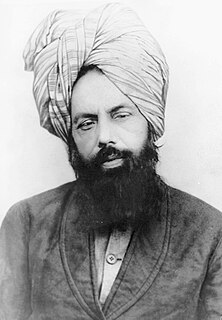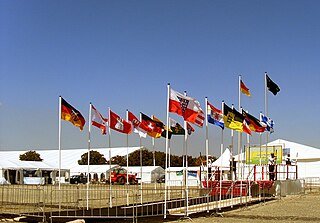The Ahmadiyya movement is a small but growing religious group in Morocco with only about five hundred adherents as of 2013. [1]
| Ahmadiyya by country |
|---|
 |
The Ahmadiyya movement is a small but growing religious group in Morocco with only about five hundred adherents as of 2013. [1]
The Ahmadiyya was officially established in Morocco in the early 1990s. [2] the number of adherents of this Islamic group has increased over the years, but very slowly. In 2013, there have been an estimated 500 Ahmadis in Morocco, [1] although the number may be much higher since some Ahmadis prefer not to openly reveal their adherence to the movement to protect themselves from persecution. [2]
Moroccan Ahmadis do not have an official place for them to practice or teach their faith, [2] although an increasing number of schools are reportedly owned by Ahmadis, especially in the cities of Salé, Casablanca, Meknes and Tangier. [1]

MirzāGhulām Ahmad was an Indian religious leader and the founder of the Ahmadiyya movement in Islam. He claimed to have been divinely appointed as the promised Messiah and Mahdi—which is the metaphorical second-coming of Jesus (mathīl-iʿIsā), in fulfillment of Islam's latter day prophecies, as well as the Mujaddid of the 14th Islamic century.

The Lahore Ahmadiyya Movement for the Propagation of Islam, is a separatist group within the Ahmadiyya movement that formed in 1914 as a result of ideological and administrative differences following the demise of Hakim Nur-ud-Din, the first Caliph after Mirza Ghulam Ahmad. Members of the Lahore Ahmadiyya movement are referred to by the majority group as ghayr mubāyi'īn and are also known colloquially as Lahori Ahmadis.

Islam was the first Abrahamic monotheistic religion to arrive in Ghana. Today, it is the second most widely professed religion in the country behind Christianity. Its presence in Ghana dates back to the 10th century. According to the Ghana Statistical Service's Population and Housing census (2021), the population of Muslims in Ghana is about 19.9%.

Islam is the major religion in the Gambia, representing 95% of the 2 million population, with the first Muslim communities in the country arriving in 11th century. Islam has therefore had an influence on the Gambia throughout history, and continues to impact its culture, society and politics. The majority of The Gambia's Muslims are Sunni belonging to the Maliki school of jurisprudence, influenced with Sufism. There is a smaller Shiite community, largely stemming form Lebanese and Arab migration. The Ahmadiyya movement is also present. Other religious societies exist in the country, including Catholics, Protestants, Hindus and Traditional African religions.

The official religion of Pakistan is Islam, as enshrined by Article 2 of the Constitution, and is practised by approximately 96.47% of the country's population. The remaining less than 4% practice Hinduism, Christianity, Ahmadiyya, Sikhism and other religions. A few aspects of Secularism have also have been adopted by Pakistani constitution from British colonial concept. However, religious minorities in Pakistan often face significant discrimination, subject to issues such as violence and the blasphemy laws.

The Ahmadiyya branch of Islam has been subject to various forms of religious persecution and discrimination since the movement's inception in 1889. The Ahmadiyya Muslim movement emerged from the Sunni tradition of Islam and its adherents believe in all the five pillars and articles of faith required of Muslims. Ahmadis are considered non-Muslims by many mainstream Muslims since they consider Mirza Ghulam Ahmad, the founder of the movement, to be the promised Mahdi and Messiah awaited by the Muslims.

Ahmadiyya, officially the Ahmadiyya Muslim Community or the Ahmadiyya Muslim Jama'at, is an Islamic revival or messianic movement originating in Punjab, British India, in the late 19th century. It was founded by Mirza Ghulam Ahmad (1835–1908), who claimed to have been divinely appointed as both the Promised Mahdi and Messiah expected by Muslims to appear towards the end times and bring about, by peaceful means, the final triumph of Islam; as well as to embody, in this capacity, the expected eschatological figure of other major religious traditions. Adherents of the Ahmadiyya—a term adopted expressly in reference to Muhammad's alternative name Aḥmad—are known as Ahmadi Muslims or simply Ahmadis.

Ahmadiyya is an Islamic branch in Indonesia. The earliest history of the community in Indonesia dates back to the early days of the Second Caliph, when during the summer of 1925, roughly two decades prior to the Indonesian revolution, a missionary of the Community, Rahmat Ali, stepped on Indonesia's largest island, Sumatra, and established the movement with 13 devotees in Tapaktuan, in the province of Aceh. The Community has an influential history in Indonesia's religious development, yet in the modern times it has faced increasing intolerance from religious establishments in the country and physical hostilities from radical Muslim groups. The Association of Religion Data Archives estimates around 400,000 Ahmadi Muslims, spread over 542 branches across the country.

The Ahmadiyya are movement that comprise a minority of Germany, numbering some 35,000–45,000 adherents and found in 244 communities as of 2013.

Ahmadiyya in Pakistan are members of the Ahmadiyya Muslim Community. The number of Ahmadiyya in the country has been variously estimated to between 0.22% and 2.2% of Pakistan's population. Hence, Pakistan is the home to the largest population of Ahmadis in the world. The city of Rabwah in the province of Punjab used to be the global headquarters of the Ahmadiyya Community before they were moved to England.

Ahmadiyya is an Islamic religious movement originating in 1889 in northern India around the teachings of Mirza Ghulam Ahmad (1835–1908), who claimed to have been divinely appointed as both the promised Mahdi and Messiah expected by Muslims to appear towards the end times.

Islam is a minority religion in the Marshall Islands. All Muslims in the country belong to the minority Ahmadiyya sect. The Ahmadiyya mosque in Uliga, first constructed in 2012 in the Marshall Islands is the only mosque in Oceania's subregion of Micronesia. According to a 2009 report there were about 10 Muslims in the Marshall Islands, although more recent reports indicate about 150 believers in the country.

Ahmadiyya is a persecuted branch of Islam in Saudi Arabia. Although there are many foreign workers and Saudi citizens belonging to the Ahmadiyya movement in Saudi Arabia, Ahmadis are officially banned from entering the country and from performing the pilgrimage to Mecca and Medina. This has led to criticisms from multiple human rights organizations.

Ahmadiyya is an Islamic branch in the United States. The earliest contact between the American people and the Ahmadiyya movement in Islam was during the lifetime of Mirza Ghulam Ahmad. In 1911, during the era of the First Caliphate of the Community, the Ahmadiyya movement in India began to prepare for its mission to the United States. However, it was not until 1920, during the era of the Second Caliphate, that Mufti Muhammad Sadiq, under the directive of the caliph, would leave England on SS Haverford for the United States. Sadiq established the Ahmadiyya Muslim Community in the United States in 1920. The U.S. Ahmadiyya movement is considered by some historians as one of the precursors to the Civil Rights Movement in America. The Community was the most influential Muslim community in African-American Islam until the 1950s. Today, there are approximately 15,000 to 20,000 American Ahmadi Muslims spread across the country.

Ahmadiyya is an Islamic community in Sweden, under the leadership of the caliph in London. The earliest history of the Community in the country begins in 1956, during the Second Caliphate, when Kamal Yousuf was appointed as the head of the mission in Sweden. However it was not until 1970 that the Community was first officially registered. Today, there are two purpose-built mosques, one of which is the oldest in the country, and also a number of other Islamic centers, representing an estimated average of 1200 Ahmadi Muslims in the country.

Ahmadiyya is an Islam branch in Ghana, under the spiritual leadership of the caliph in London. The early rise of the Community in Ghana can be traced through a sequence of events beginning roughly at the same time as the establishment of the worldwide Community in 1889 in British India. It was during the early period of the Second Caliphate that the first missionary, Abdul Rahim Nayyar was sent to what was then the Gold Coast in 1921 upon invitation from Muslims in Saltpond. Having established the Ahmadiyya movement in the country, Nayyar left and was replaced by the first permanent missionary, Al Hajj Fadl-ul-Rahman Hakim in 1922.

Ahmadiyya is an Islamic community in Kyrgyzstan, whose teachings were first brought into the country by foreign Pakistani missionaries in the early 1990s. Although the Community was first registered in the country in 2002, its registration was struck off with the country's State Commission on Religious Affairs refusing to re-register it in 2011. Today, the Community which faces religious persecution, represents up to 1000 members spread across the capital Bishkek and three other regions of the country.

Ahmadiyya is a religious sect in Algeria, with around 2,000 followers. Its presence in the country dates back to the 1970s.

'Ahmadiyya under the spiritual leadership of the caliph in London is considered as an Islamic community in China. Although the history of the Ahmadiyya movement in China starts in the early 20th century, reportedly during the lifetime of the first caliph of the movement, Hakeem Noor-ud-Din, there are no known organized Ahmadi communities in existence, besides a number of refugees, students and expatriates. The Chinese section of the movement is itself based in Surrey, United Kingdom, as opposed to being based in China.

The Ahmadiyya is an Islamic movement in Egypt with origins in the Indian subcontinent. Although the earliest contact between Egyptians and the Ahmadiyya movement was during the lifetime of Mirza Ghulam Ahmad, its founder, the movement in Egypt was formally established in 1922 under the leadership of its second Caliph Opposition to the Ahmadiyya grew particularly in the latter part the 20th century and Ahmadis have seen increased hostility in Egypt more recently. There are up to 50,000 Ahmadi Muslims in Egypt. Although the group is not officially recognised by the state.